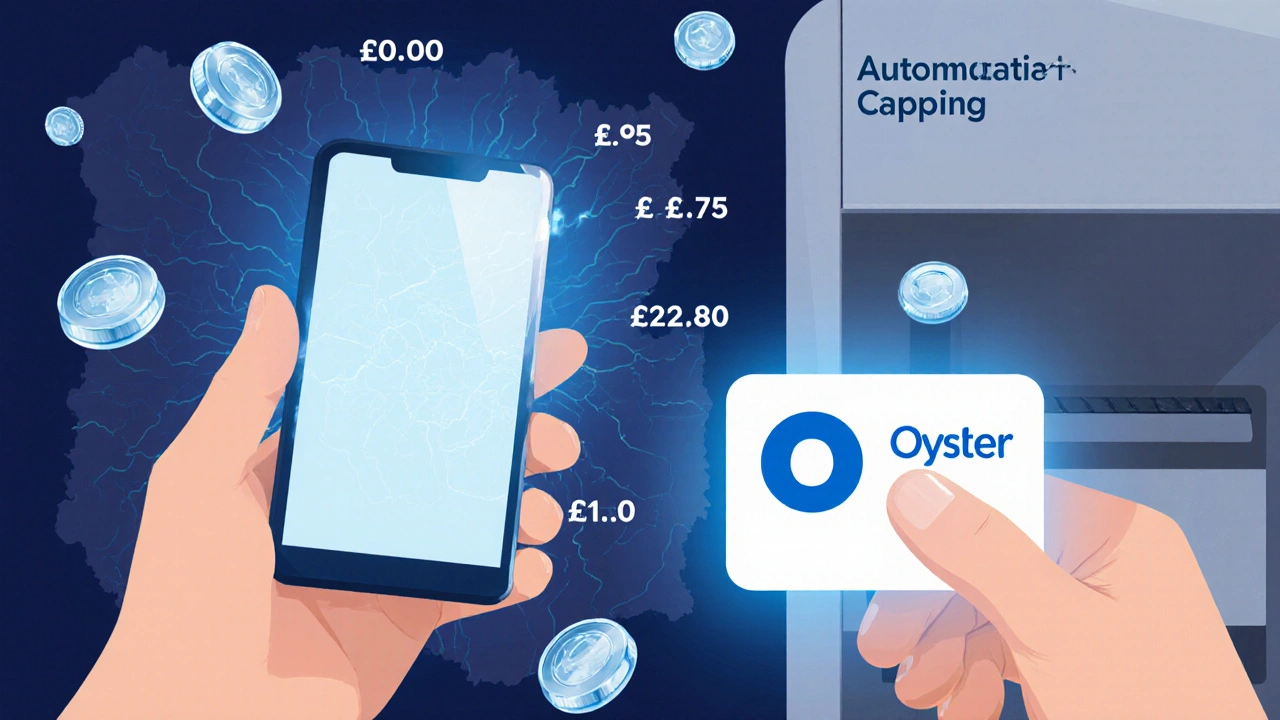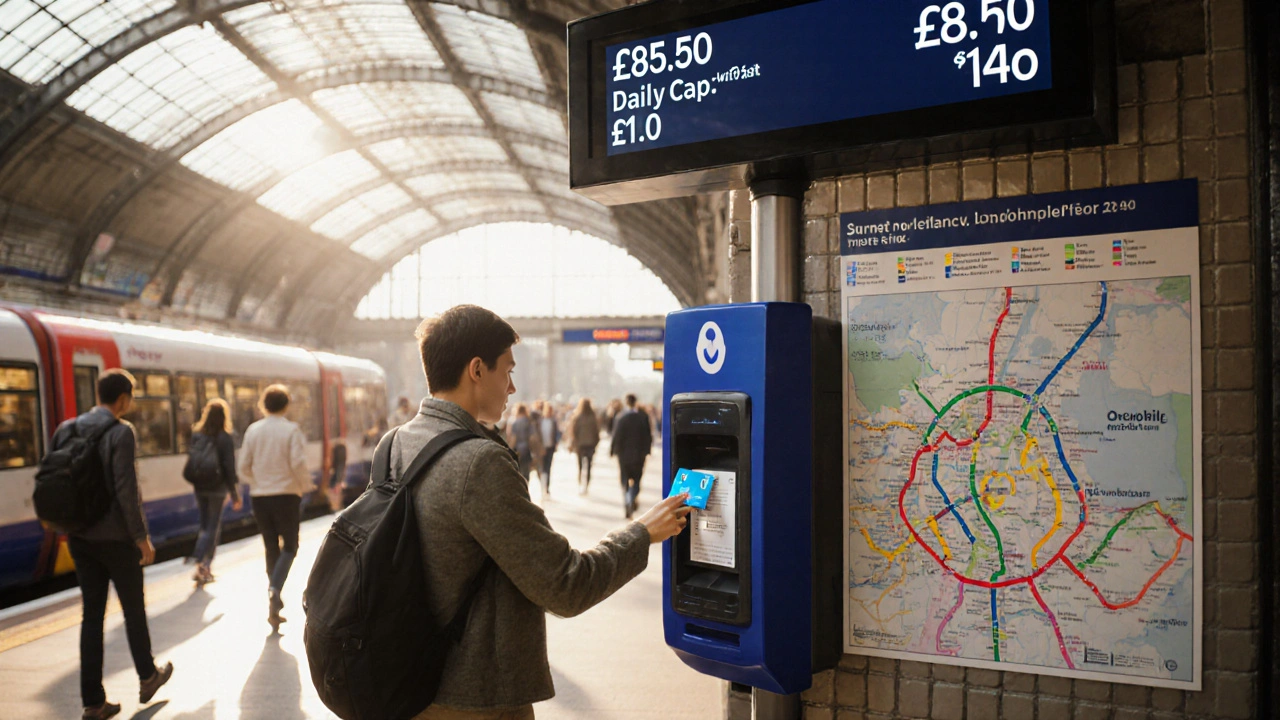When you first use an Oyster card in London, you might think you’re paying full fare every time you hop on the Tube, bus, or DLR. But here’s the secret most tourists miss: you’re never charged more than a set amount in a single day or week. That’s called capping, and it’s one of the smartest money-saving features in urban transit.
What Is Oyster Card Capping?
Oyster card capping means your total fare for a day or week stops growing once you hit a limit-no matter how many trips you take. It’s automatic. You don’t need to do anything extra. Just tap in and out like normal. The system tracks your spending and blocks you from paying more than the cap.
Think of it like an all-you-can-eat buffet. You can eat five plates, or ten. But once you hit the price, you’re done paying. Same with Oyster. Take five Tube rides? Fine. Take ten bus trips and two Overground trains? Still capped.
Daily Caps: How Much You Really Pay
London’s daily cap depends on where you travel and which zones you cross. Here’s what it looks like in 2025:
- Zones 1-2: £8.50 per day
- Zones 1-3: £10.40 per day
- Zones 1-4: £12.70 per day
- Zones 1-5: £15.60 per day
- Zones 1-6: £16.10 per day
These caps apply to all combinations of Tube, bus, DLR, London Overground, Elizabeth line (within zones), and National Rail services within those zones. If you only take buses, your daily cap is £5.25-much cheaper than paying £1.75 per ride.
Let’s say you take the Tube from Zone 1 to Zone 2 in the morning (£2.80), then a bus to a museum (£1.75), then a train to Zone 4 in the afternoon (£3.60), and finally a bus home (£1.75). That’s £9.90 in fares. But because you hit the £8.50 cap for Zones 1-2, you only pay £8.50. The system refunds the extra £1.40 automatically.
Weekly Caps: The Hidden Gem for Longer Stays
Most people don’t know about the weekly cap. It kicks in from Monday to Sunday. Once you’ve paid the equivalent of a 7-day Travelcard in pay-as-you-go fares, you stop paying for the rest of the week.
Here are the weekly caps for 2025:
- Zones 1-2: £42.50
- Zones 1-3: £52.00
- Zones 1-4: £63.50
- Zones 1-5: £78.00
- Zones 1-6: £80.50
Compare that to buying a 7-day Travelcard: it’s the same price. But with Oyster, you don’t have to buy anything in advance. You just keep tapping. If you only travel four days that week, you pay less. If you travel every day, you still won’t pay more than the cap.
For example: You’re staying in London for 10 days. You travel Monday through Friday in Zones 1-2. That’s five days × £8.50 = £42.50. You hit the weekly cap on Friday. Saturday and Sunday? Free rides. You didn’t pay extra. You didn’t need a weekly ticket. You just kept tapping.
How Capping Works Behind the Scenes
The system doesn’t cap you after exactly five rides. It tracks your total spending from midnight to midnight. Every time you tap in, it adds the fare to your running daily total. If you’ve already spent £8.50 in Zones 1-2 by 3 p.m., your next Tube ride costs £0.00. No pop-up. No warning. Just free travel.
It also combines modes. Bus rides count toward your Tube cap. Train rides count toward your bus cap. That’s why taking a bus and then a Tube doesn’t double your cost-it just adds up until the cap.
And here’s the kicker: contactless cards work the same way as Oyster. You don’t need to buy a physical card. Just tap your phone, Apple Watch, or credit card. The system treats them identically.
What Doesn’t Count Toward Capping?
Not all transport is included. Here’s what’s excluded:
- Heathrow Express
- Thames Clippers river buses
- Night buses (they have their own cap: £5.25 daily)
- Trams (they count, but only within Zone 3-5)
- Travel outside Greater London (e.g., to Gatwick or Stansted)
Also, capping doesn’t apply to rail services outside the TfL network, like Southeastern or Greater Anglia, unless they’re marked as part of the Oyster system. Always check the station signs-if it says “Oyster accepted,” it counts.
Real-Life Savings: A Week in London
Imagine you’re visiting London for a week. You stay in Zone 2 and plan to see the British Museum, Tate Modern, Camden Market, and the Tower of London-all in Zones 1-2.
You take the Tube to the museum on Monday: £2.80
Bus to lunch: £1.75
Tube to Tate: £2.80
Bus to Camden: £1.75
Tube to Tower: £2.80
Bus back: £1.75
That’s £13.65 in fares. But you only pay £8.50. You saved £5.15 in one day.
Do that every day for five days? You’d pay £42.50 total. That’s the weekly cap. You didn’t buy a ticket. You didn’t plan ahead. You just tapped and went.
Now imagine buying five single 7-day Travelcards. That’s £212.50. You’d be paying 5x more.
Pro Tips to Maximize Your Savings
- Use the same card or device every time. Switching between cards breaks your cap. The system can’t track your spending across multiple cards.
- Don’t top up too much. Oyster cards can hold up to £90. If you’re only staying a few days, £30 is plenty. You won’t need more.
- Check your balance on a ticket machine. Look for the “Transaction History” option. It shows your daily and weekly totals.
- Use contactless if you don’t have an Oyster card. Same caps. Same savings. No need to queue at a machine.
- Travel after 9:30 a.m. on weekdays. Off-peak fares are cheaper, and caps still apply. Same price, less crowding.

Common Mistakes People Make
Even seasoned travelers mess this up.
Mistake 1: Buying a weekly Travelcard before knowing if they’ll use it enough.
Don’t. Pay-as-you-go with capping is always better unless you’re traveling 7 days straight, 10+ times a day.
Mistake 2: Using a different card for buses and Tube.
If you tap with your phone on the Tube and your debit card on the bus, you’ll pay full fare twice. The system sees two separate users.
Mistake 3: Thinking capping applies to airport transfers.
Heathrow Express? £25 one-way. No cap. That’s a separate system. Use the Piccadilly Line instead-it’s £6.40 and included in capping.
What If I’m a Tourist with a Foreign Card?
You don’t need an Oyster card. Just tap your contactless Visa, Mastercard, or Apple Pay. London’s system accepts foreign cards with no extra fees. Your bank might charge a small foreign transaction fee, but that’s still cheaper than buying tickets.
Some travelers worry about currency conversion. Don’t. The fare is charged in pounds. Your bank converts it at the daily rate. You still get capped. You still save.
Just make sure your card supports contactless payments. If it has the wave symbol, it works.
Final Rule: Tap Every Time
The biggest reason people get charged more than they should? They forget to tap out.
If you tap in but not out, the system charges you the maximum fare for that journey-up to £9.40 for a single Zone 1-6 Tube ride. That can wreck your cap. You might pay £9.40 for one trip, then hit your daily cap on the next ride. Suddenly you’ve spent £17.90 instead of £8.50.
Always tap out. Even if you’re just getting off at the next stop. Even if you’re tired. Even if you’re with kids. Tap out.
And if you forget? Go to a ticket machine and select ‘Touch Out’ or ‘Incomplete Journey.’ You can fix it within 48 hours. But don’t wait.
Bottom Line: Capping Is Your Best Friend
Oyster card capping turns London’s transport from a budget killer into a budget saver. You don’t need a pass. You don’t need to plan routes in advance. You don’t need to calculate fares. Just tap in, tap out, and let the system do the math.
For a week in London, you could easily save £50-£100 just by using capping right. That’s a free dinner. Or two museum tickets. Or a day trip to Windsor.
It’s not magic. It’s just smart design. And now you know how to use it.
Do daily and weekly caps work together?
Yes. Your daily cap resets every day at 4:30 a.m. Your weekly cap runs Monday to Sunday. If you hit your daily cap on Tuesday, you still keep riding. That Tuesday’s spending counts toward your weekly total. Once your weekly cap is reached, all further travel that week is free-even if you haven’t hit your daily cap yet.
Can I use Oyster capping on the Night Tube?
Yes. Night Tube services (Friday and Saturday nights) are included in the same caps as daytime travel. The daily cap for Zones 1-2 is still £8.50, even if you take three Night Tube rides after midnight. Just tap in and out like normal.
What if I travel outside the zones covered by my cap?
If you go beyond your usual zones-for example, from Zone 1-2 to Zone 4-the system automatically switches to the higher cap. You’ll be charged the Zone 1-4 daily rate (£12.70) instead of Zone 1-2 (£8.50). You don’t need to do anything. The system adjusts based on your journey history.
Is capping better than a Travelcard?
For most visitors, yes. Travelcards are only better if you’re taking 10+ trips every single day for 7 days straight. If you’re sightseeing, taking breaks, or only traveling 3-5 days a week, pay-as-you-go with capping saves money and gives you flexibility.
Do children get capped fares?
Children under 11 travel free on all TfL services when accompanied by an adult. Kids 11-15 need a Zip Oyster photocard for child fares, which have their own lower caps. For example, the Zones 1-2 daily cap for a child is £4.25. Without a Zip card, they’re charged adult fares.
